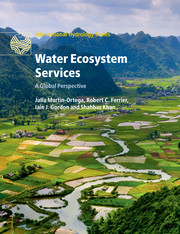Book contents
- Frontmatter
- Contents
- List of contributors
- Preface
- 1 Introduction
- 2 What defines ecosystem services-based approaches?
- Part I Addressing global challenges
- Part II Applying frameworks for water management and biodiversity conservation under an ecosystem services-based approach
- Part III Assessing water ecosystem services
- 9 The first United Kingdom's National Ecosystem Assessment and beyond
- 10 Using an ecosystem services-based approach to measure the benefits of reducing diversions of freshwater: a case study in the Murray-Darling basin, Australia
- 11 An ecosystem services-based approach to integrated regional catchment management: the South East Queensland experience
- 12 Policy support systems for the development of benefit-sharing mechanisms for water-related ecosystem services
- 13 Assessing biophysical and economic dimensions of societal value: an example for water ecosystem services in Madagascar
- 14 Rapid land use change impacts on coastal ecosystem services: a South Korean case study
- Part IV Broadening the perspective
- Index
- Plate Section
- References
11 - An ecosystem services-based approach to integrated regional catchment management: the South East Queensland experience
from Part III - Assessing water ecosystem services
Published online by Cambridge University Press: 05 May 2015
- Frontmatter
- Contents
- List of contributors
- Preface
- 1 Introduction
- 2 What defines ecosystem services-based approaches?
- Part I Addressing global challenges
- Part II Applying frameworks for water management and biodiversity conservation under an ecosystem services-based approach
- Part III Assessing water ecosystem services
- 9 The first United Kingdom's National Ecosystem Assessment and beyond
- 10 Using an ecosystem services-based approach to measure the benefits of reducing diversions of freshwater: a case study in the Murray-Darling basin, Australia
- 11 An ecosystem services-based approach to integrated regional catchment management: the South East Queensland experience
- 12 Policy support systems for the development of benefit-sharing mechanisms for water-related ecosystem services
- 13 Assessing biophysical and economic dimensions of societal value: an example for water ecosystem services in Madagascar
- 14 Rapid land use change impacts on coastal ecosystem services: a South Korean case study
- Part IV Broadening the perspective
- Index
- Plate Section
- References
Summary
11.1 AN ECOSYSTEM SERVICES-BASED APPROACH TO INTEGRATED REGIONAL CATCHMENT MANAGEMENT
The importance of ecosystem services to sustainable development and the well-being of communities is well recognised and has been emphasised in many international policies and programmes (World Commission on Environment and Development 1987; Millennium Ecosystem Assessment 2005; European Commission et al. 2012). In recognition of this importance, stakeholders (e.g. government, non-government, business, industry, community, Traditional Owners, researchers) across South East Queensland (Australia) came together to develop the South East Queensland Ecosystem Services Framework, a tool to identify, measure, and value the ecosystem services provided by the region (Maynard et al. 2010, 2012). The Framework, which operationalises an ecosystem services-based approach, is described briefly in this chapter; also given is an example of the Framework's application to better align land use planning and on-ground catchment management.
Box 11.1 Evolution of integrated catchment management in South East Queensland, Australia
• Community-led watershed management was underway in the Lockyer catchment, the ‘food bowl’ of the South East Queensland region, in the early 1980s.
• Integrated Catchment Management was officially adopted as a natural resource management programme in the state of Queensland in the early 1990s.
• Integrated Catchment Management emerged from concerns relating to the degradation of natural resources; conflicting government policies; and increasing public expectations for involvement in decision-making.
• The national Regional Natural Resource Management Body network established by the Australian government evolved from these initiatives.
• Each region has a Regional Body whose primary role is to work with stakeholders to better manage the natural resources of the region.
‘Integrated Catchment Management’ takes a catchment-scale approach to the management of natural resources (Murray Darling Basin Commission 2001; Falkenmark 2004). Catchments are explicitly defined structures; they represent the natural order of landscape processes and provide spatial gradients and thus water pathways and soil generation profiles. These gradients determine the vegetation cover and ecological structure of the catchment, which in turn influence the spatial organisation of human settlements (Priscoli 1999).
- Type
- Chapter
- Information
- Water Ecosystem ServicesA Global Perspective, pp. 90 - 98Publisher: Cambridge University PressPrint publication year: 2015
References
- 2
- Cited by



